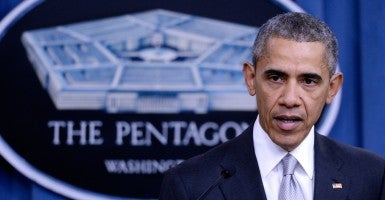President Barack Obama’s statement at the Pentagon on Monday was sadly no more than political theater. Facing a crisis of confidence over the public perception of his handling of the Islamic State (ISIS), the president is trying to again make the case that his strategy is the right one.
Despite the change (upward) in the threat level from ISIS, and the president himself saying we are entering a “new stage” in our struggle, he still wants us to buy into the story that what he has done so far is enough.
Despite the change in backdrop (Oval Office last week, Pentagon press room Monday), Obama once again failed to spell out a winning strategy that would destroy ISIS.
Just saying “we are hitting ISIS harder than ever” does not make it so. The administration’s strategy over the past 14 months has led to the rise of Russia and Iran in the region, an expansion of ISIS into Afghanistan and Yemen, and the re-emergence and entrenchment of Bashar al-Assad in Syria.
The meager use of air power is one huge deficiency. The operation averages 7 to 10 sorties a day, compared to 150-200 per day in almost all the operations conducted in the last 20 years. Add to that the fact that nearly 75 percent of those sorties return to base with their ordnance still on the aircraft wing mounts, having dropped nothing on the ISIS terrorists. This is the result of overly restrictive rules of engagement, without qualified “on the ground” air controllers.
The operation averages 7 to 10 sorties a day, compared to 150-200 per day in almost all the operations conducted in the last 20 years.
The result of this impotent effort is that the terrorists will continue to recruit while ISIS exists. The American failure to utterly destroy ISIS is seen by would be jihadists as prima facie evidence that the ISIS claim of Allah’s blessing is true. Only by the devastation of ISIS will this magnet be eliminated.
The most efficient way to do this would be a full-scale use of U.S. and Western military conventional forces, but no one wants that today. There is an alternative route (if the president can gain the stomach for it).
The president must be decisive and ask the Pentagon to execute a strategy that will crush ISIS. Such a strategy has three major parts. It must dramatically increase special operators in the field, to train, advise, and fight with the local boots on the ground. It must de-clutter combat engagement orders for already deployed troops and allow them to strike critical targets such as the oil trucks, which were finally hit only a week or so ago. Finally, the number and type of air strikes must be dramatically increased to the level of almost every other previous operation. The final “extra” step is that the president must at least consider the use of ground forces. The ISIS threat is significant and warrants a prudent and real leader to at least ask his military advisers to provide a plan that covers this contingency.
Our nation is being threatened, not by rising tides in a half-century, but by fanatics today. It is time for the president to realize he’s the commander in chief and act to defend against ISIS rather than apologize to the world.




























